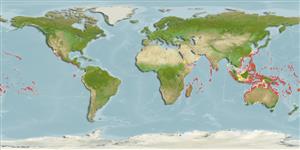Classification / Names
Common names from other countries
Main reference
Size / Weight / Age
Max length : 2.4 cm SL male/unsexed; (Ref. 1602)
Environment
Marine; reef-associated; non-migratory; depth range 2 - 30 m (Ref. 58302)
Climate / Range
Tropical, preferred ?; 30°N - 35°S
Distribution
Indo-Pacific: Red Sea to Johnston Island and Pitcairn, north to Japan, south to Australia. Replaced by Priolepis farcimen in the Hawaiian Islands (Ref. 37816).
Countries | FAO areas | Ecosystems | Occurrences | Introductions
Short description
Dorsal
spines
(total): 7;
Dorsal
soft rays
(total): 8;
Anal
spines: 1;
Anal
soft rays: 7. Scales mostly restricted to the abdomen. Has relatively wide (> or = pupil diameter) light bars from the snout to the pectoral base, and few if any scales anterior of the operculum. Very similar to P. farcimen.
IUCN Red List Status (Ref. 115185)
Threat to humans
Harmless
Human uses
Aquarium: commercial
More information
Common namesSynonymsMetabolismPredatorsEcotoxicologyReproductionMaturitySpawningFecundityEggsEgg development
ReferencesAquacultureAquaculture profileStrainsGeneticsAllele frequenciesHeritabilityDiseasesProcessingMass conversion
Tools
Special reports
Download XML
Internet sources
Estimates of some properties based on models
Phylogenetic diversity index
PD50 = 0.5000 many relatives (e.g. carps) 0.5 - 2.0 few relatives (e.g. lungfishes)
Trophic Level
3.1 ±0.3 se; Based on size and trophs of closest relatives
Resilience
High, minimum population doubling time less than 15 months (Preliminary K or Fecundity.)
Vulnerability
Low vulnerability (10 of 100)
Price category
